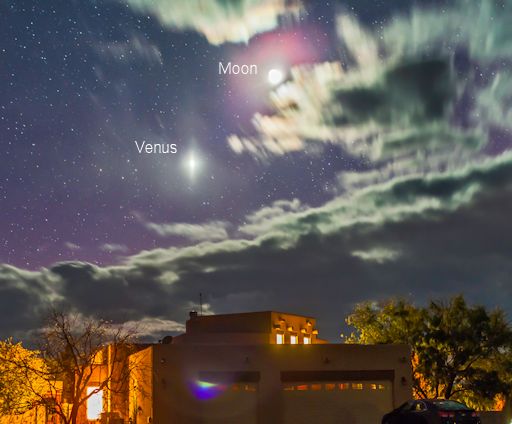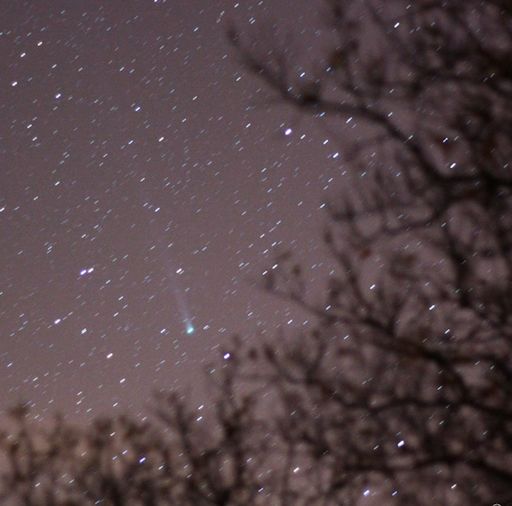CONTINUED QUIET: The sun's southern hemisphere is peppered with sunspots, but none of them is strongly flaring. Solar activity remains low. NOAA forecasters estimate a 15% chance of M-class solar flares and a scant 1% chance of X-flares on Dec. 6th. Solar flare alerts: text, voice
MAXIMUM VENUS: Have you noticed an extremely luminous star in the southwest after sunset? That's no star. It's Venus, and tonight it is at its brightest for all of 2013. Only the Moon itself outshines the 2nd planet from the sun:
Alan Dyer took the picture from a spot near Rodeo, New Mexico, on Dec. 5th. "The clouds cleared just in time for us to catch a glimpse of the crescent Moon above Venus, now at its most brilliant for the year."
Venus registers -4.7 on the scale of astronomical magnitudes. That means it is almost 200 times brighter than a 1st-magnitude star. If you have binoculars or a small telescope, take a closer look. Like the Moon, Venus has phases and tonight it is 27% illuminated. The bright Venusian crescent is easy to see through backyard optics.
Realtime Space Weather Photo Gallery
WHO NEEDS COMET ISON? Astronomers are mourning the loss of Comet ISON, which disintegrated when it flew past the sun on Thanksgiving Day (Nov. 28). Who needs it? There is another comet brightening in the morning sky--naked-eye Comet Lovejoy (C/2013 R1). Martin McKenna sends this report from Northern Ireland: "This morning, the comet was easily visible as a fuzzy star of 4th magnitude with a long straight tail between the constellations Bootes and Hercules." He took this picture using a Canon 450D digital camera:
"I could see 5 degrees of tail with my unaided eye," continues McKenna. "Using the camera the tail was at least 10o long!"
Telescopes and longer exposures reveal much more. This image from Michael Jäger of Masenberg, Austria, shows a "disconnection event" disrupting the comet's tail on Dec. 5th. The disturbance could be caused by a gust of solar wind or perhaps an episode of vigorous outgassing in the comet's core.
Monitoring is encouraged. Comet Lovejoy is easy to find before dawn rising in the east before the sun. Sky maps: Dec. 6, 7, 8, 9.

Solar wind
speed: 333.1 km/sec
density: 7.6 protons/cm3
explanation | more data
Updated: Today at 2306 UT
X-ray Solar Flares
6-hr max: C2 2104 UT Dec06
24-hr: C2 0648 UT Dec06
explanation | more data
Updated: Today at: 2300 UT
![]()
Daily Sun: 06 Dec 13
Sunspot AR1909 has decayed and no longer poses a threat for M-class solar flares. Credit: SDO/HMI
![]()
Sunspot number: 103
What is the sunspot number?
Updated 06 Dec 2013
Spotless Days
Current Stretch: 0 days
2013 total: 0 days (0%)
2012 total: 0 days (0%)
2011 total: 2 days (<1%)
2010 total: 51 days (14%)
2009 total: 260 days (71%)
Since 2004: 821 days
Typical Solar Min: 486 days
Update 06 Dec 2013
The Radio Sun
10.7 cm flux: 150 sfu
explanation | more data
Updated 06 Dec 2013
![]()
Current Auroral Oval:
Switch to: Europe, USA, New Zealand, Antarctica
Credit: NOAA/POES
![]()
Planetary K-index
Now: Kp= 1 quiet
24-hr max: Kp= 1 quiet
explanation | more data
Interplanetary Mag. Field
Btotal: 4.2 nT
Bz: 3.4 nT south
explanation | more data
Updated: Today at 2306 UT
![]()
Coronal Holes: 06 Dec 13
A stream of solar wind flowing from the indicated coronal hole should reach Earth on Dec. 8-9. Credit: SDO/AIA.






